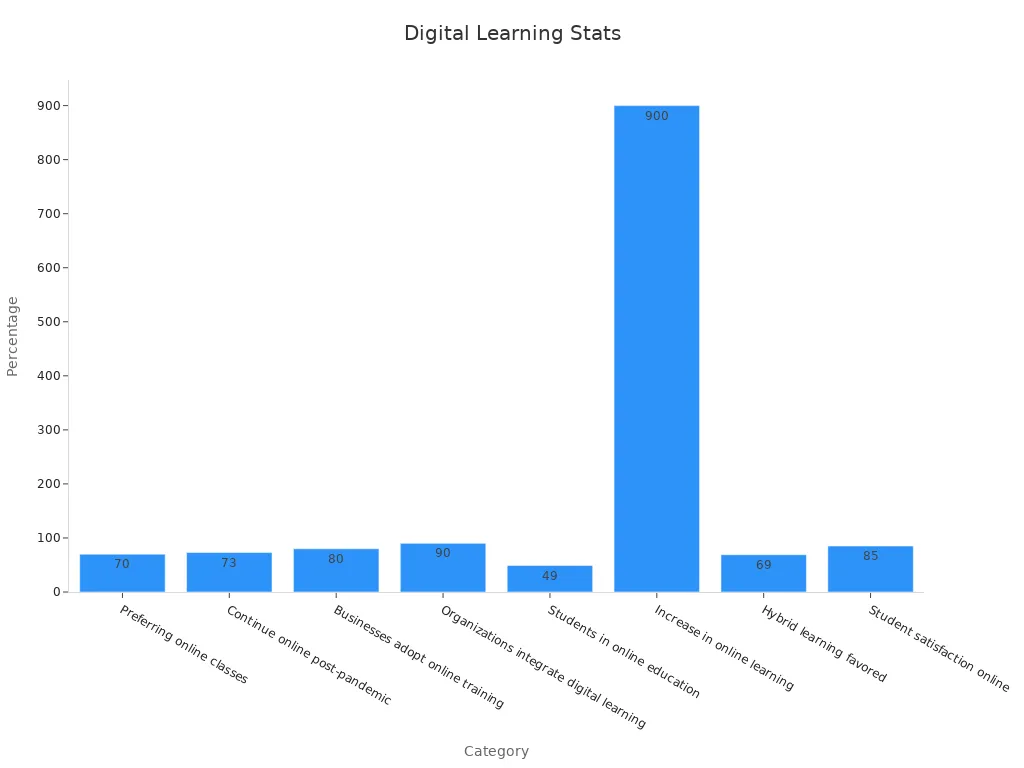
Digital learning resources play a key role in transforming how you learn. These are electronic tools, platforms, or materials designed to make learning more engaging and effective. From interactive apps to online courses, they offer a variety of ways to access knowledge.
In recent years, the adoption of digital learning has skyrocketed. For example:
The e-learning market is expected to reach $325 billion by 2025, growing at 7% annually.
By 2023, 98% of corporations plan to use e-learning for training.
Over 90% of U.S. companies already offer digital learning options.
Whether you're a student, teacher, or lifelong learner, a digital learning resource can help you explore new subjects, develop skills, and reach your goals.
Digital learning tools make education fun, easy, and available to everyone.
Learning at your own pace helps you remember more and suits different ways of learning.
Digital tools make working with others simple, even with people far away, and improve teamwork.
Personalized learning adjusts to what you need, keeping you motivated and helping you get better where needed.
Use different digital tools like e-books, online classes, and apps to make learning more exciting.
A digital learning resource refers to any electronic tool, platform, or material designed to support and enhance your learning experience. These resources leverage technology to deliver knowledge in innovative ways, making education more accessible and engaging. Over the years, digital learning resources have evolved significantly, adapting to the changing needs of learners and educators.
Early Use of Technology: Computers were first integrated into education during the mid-20th century, offering basic computer-assisted instruction.
Web-Based Learning: The 1990s introduced web-based learning, which expanded access to educational materials.
Learning Management Systems: Platforms like LMS emerged in the late 1990s and early 2000s, structuring the delivery of educational content.
Blended Learning Models: Combining traditional and online methods, blended learning provided greater flexibility.
Online Learning Platforms: MOOCs revolutionized education in the early 21st century, offering affordable access to quality courses.
Impact of COVID-19: The pandemic accelerated the adoption of online learning, highlighting the importance of digital tools in education.
These milestones demonstrate how digital learning resources have transformed education, enabling you to learn anytime, anywhere.
Digital learning resources stand out due to their unique features, which differentiate them from traditional methods. These characteristics make them versatile and effective for learners of all ages.
Characteristic | Digital Learning Resources | Traditional Methods |
|---|---|---|
Engagement | Active engagement through interactive content | Group activities and discussions |
Instructional Design | Subject-specific pedagogy leveraging technology | Constructivist methods in physical settings |
Learning Environment | Flexible and adaptable to various contexts | Fixed classroom settings |
Authentic Experiences | Virtual tours and collaborative projects | Hands-on experiments and real-world applications |
Digital learning resources provide flexibility, allowing you to learn at your own pace and in your preferred environment. Interactive content keeps you engaged, while virtual tools offer authentic experiences that mimic real-world scenarios. These features make digital learning resources a powerful tool for modern education.

Online digital learning resources are tools and platforms that require an internet connection to function. These resources have become increasingly popular due to their accessibility and convenience. You can access them from anywhere, making them ideal for remote learning or self-paced education. Examples include e-learning platforms, video tutorials, and virtual classrooms.
The widespread adoption of online learning is supported by compelling statistics:
Statistic | Value |
|---|---|
Percentage of students preferring online classes | |
Students wanting to continue online classes post-pandemic | 73% |
Businesses adopting online training solutions | 80% |
Organizations integrating digital learning | 90% |
Students participating in online education | 49% |
Increase in online learning since 2000 | 900% |
Improved retention rates compared to traditional methods | 25% to 60% |
Students favoring online, hybrid, or blended learning | 69% |
Student satisfaction with online learning | 85% |

These statistics highlight the growing preference for online learning and its effectiveness in delivering quality education.
Offline digital learning resources do not require an internet connection. These resources are perfect for situations where connectivity is limited or unavailable. You can use them to learn at your own pace without worrying about network issues. Examples include downloaded e-books, pre-installed educational software, and offline-accessible videos.
Offline resources are particularly useful in areas with poor internet infrastructure. They ensure that learning remains uninterrupted, even in challenging environments. By using these tools, you can focus on your studies without distractions from online notifications or connectivity problems.
Hybrid digital learning resources combine online and offline elements to create a flexible and engaging learning experience. These resources allow you to switch between connected and disconnected modes, depending on your needs. For instance, you might attend live online classes while using offline materials for practice and review.
Recent research highlights the benefits of hybrid learning:
Improved Engagement & Flexibility: You gain more control over your learning, which enhances understanding and retention.
Better Outcomes When Done Right: Well-structured hybrid programs lead to higher average scores (15–20%) compared to traditional models, as reported by the Education Research Institute in 2023.
Challenges Still Exist: Time management and digital fatigue can pose challenges for some learners.
Teachers Need Support, Too: Educators require ongoing training to effectively manage hybrid learning environments.
Hybrid digital learning resources offer the best of both worlds. They provide the convenience of online tools and the reliability of offline materials, making them a versatile choice for modern education.

E-books and digital textbooks have revolutionized the way you access learning materials. These resources offer portability, affordability, and interactive features that traditional textbooks cannot match. You can carry multiple textbooks on a single device, making it easier to study wherever you are.
Feature/Benefit | Description |
|---|---|
Cost-effectiveness | Digital textbooks are generally more affordable than traditional textbooks. |
Enhanced portability | Students can carry multiple textbooks on a single device. |
Interactive features | Features like multimedia content, hyperlinks, and annotations improve engagement and comprehension. |
Increased learner engagement | Multimedia elements stimulate cognitive processes, enhancing understanding of concepts. |
Support for collaborative learning | Features like note-sharing foster connections among students and enhance the learning experience. |
Positive learning outcomes | Students using interactive features report better coursework completion and learning experiences. |
These benefits make e-books and digital textbooks a valuable digital learning resource for modern education.
Online courses and MOOCs (Massive Open Online Courses) provide you with access to high-quality education from top institutions and experts worldwide. These platforms cater to diverse learning needs, offering courses in subjects ranging from coding to creative writing. You can learn at your own pace, making them ideal for self-directed learners.
Diverse Online Tutoring Platforms: Platforms like Khan Academy and Coursera have successfully catered to different learning needs, demonstrating flexibility and accessibility.
Cambridge Public Schools (MA): During the COVID-19 pandemic, this district implemented a 1:1 device program for grades 9-12, distributing laptops and hotspots to ensure digital equity.
Online Tutoring Success Stories: Research shows that online tutoring has significantly improved math skills for socioeconomically disadvantaged students through targeted programs.
These examples highlight how online courses and MOOCs empower you to learn effectively, regardless of your location or background.
Educational apps and games combine learning with fun, making them highly engaging for students of all ages. These tools use interactive and immersive experiences to teach subjects like math, science, and language arts.
The global game-based learning market was valued at approximately USD 16.16 billion in 2023. It is expected to grow at a compound annual growth rate (CAGR) of 22.0% from 2024 to 2030. This growth reflects the increasing demand for interactive learning experiences driven by advancements in AI, AR, and VR.
Game-based learning also enhances your motivation and academic performance. A study from the National Library of Medicine in 2023 found that students using educational games showed improved attitudes and achievements, especially in mathematics.
Whether you’re solving puzzles or exploring virtual worlds, educational apps and games make learning enjoyable and effective.
Virtual Reality (VR) and Augmented Reality (AR) tools are transforming how you learn by creating immersive and interactive experiences. These technologies allow you to explore complex concepts in a hands-on way, making learning more engaging and effective. For example, VR can simulate real-world environments, while AR overlays digital information onto your physical surroundings.
Studies show that VR and AR tools significantly improve learning outcomes compared to traditional methods. Here’s how they perform:
Metric | VR Training | Traditional Training |
|---|---|---|
Retention Rate | 80% after a year | 30% after a day |
Performance Improvement | 40% | N/A |
Focus Level | 4x more focused | N/A |
Confidence Increase | 275% | N/A |
Time Reduction | 6.5x | N/A |
Injury Reduction | 43% | N/A |
These tools help you retain information longer and improve your focus. They also boost your confidence by allowing you to practice in a risk-free environment. For instance, medical students can use VR to perform virtual surgeries, reducing the chances of errors in real-life scenarios.
By using VR and AR, you can experience lessons in a way that feels real. This makes learning not only more effective but also more enjoyable.
Learning Management Systems (LMS) are platforms that help you organize, deliver, and track educational content. They are widely used in schools, universities, and businesses to streamline learning processes. With an LMS, you can access courses, submit assignments, and track your progress all in one place.
Here’s a comparison of popular LMS platforms:
LMS Name | User Base | SQTL Score | Licenses |
|---|---|---|---|
LMS 1 | 5000 | 85 | 100 |
LMS 2 | 3000 | 78 | 50 |
LMS 3 | 10000 | 90 | 200 |
Using an LMS offers several benefits:
It improves productivity by organizing learning materials efficiently.
It increases engagement by providing interactive features like quizzes and discussion forums.
It delivers a strong return on investment by helping you develop valuable skills.
An LMS makes learning more accessible and manageable. Whether you’re a student or a professional, it simplifies the process of acquiring new knowledge and skills.
Digital learning resources can transform your classroom experience by making lessons more interactive and engaging. Tools like educational apps, gamified simulations, and virtual reality create opportunities for active participation. For example, a study found that 97% of 149 students believed gamified simulations made learning more engaging. These tools help you grasp complex concepts through hands-on activities and visual aids.
Teachers also benefit from these resources. They can use platforms like Learning Management Systems (LMS) to organize lessons, track progress, and provide personalized feedback. This streamlines classroom management and allows educators to focus on teaching.
However, challenges like decreased engagement or isolation can arise if digital tools are not used effectively. To address this, teachers often combine traditional methods with digital tools to maintain a balance. This approach ensures that you stay connected with your peers while enjoying the benefits of technology.
Self-paced learning is one of the most significant advantages of digital learning resources. These tools allow you to learn at your own speed, accommodating different learning styles and schedules. Whether you prefer to dive deep into a topic or revisit materials multiple times, self-paced platforms provide the flexibility you need.
Feature | Benefit |
|---|---|
Supports various learning speeds | Accommodates independent learners |
Enables deep diving | Allows exploration of topics of interest |
Personalized study schedules | Flexibility in learning pace |
Unlimited content review | Facilitates thorough understanding |
Practice at individual pace | Supports different learning approaches |
You can access courses anytime and anywhere, making it easier to fit learning into your daily routine. For instance, you might review a lesson during your commute or practice a skill in the evening. This flexibility empowers you to take control of your education and achieve better outcomes.
Studies have shown that self-paced learning improves academic performance. The ability to revisit materials and learn at your own pace helps you retain information more effectively. This approach is particularly beneficial for independent learners who thrive in a flexible environment.
Collaboration is a vital part of education, and digital learning resources make it easier than ever to work with others. Tools like virtual classrooms, discussion forums, and shared documents allow you to connect with peers and collaborate on projects. These platforms break down geographical barriers, enabling you to work with classmates from around the world.
Research has highlighted the importance of collaboration in improving engagement and performance. A review of 18 peer-reviewed studies found that online learning platforms enhance student engagement when used effectively. However, they also noted challenges like isolation, which can be mitigated by fostering a sense of community through collaborative tools.
For example, virtual classrooms let you participate in group discussions and share ideas in real time. Shared documents enable you to work on assignments together, even if you're in different locations. These tools not only improve your teamwork skills but also make learning more enjoyable.
By using digital learning resources, you can collaborate with others in ways that were not possible before. This fosters a deeper understanding of the material and helps you develop essential skills for the future.
Digital learning resources have revolutionized how you access knowledge, breaking down geographical and socioeconomic barriers. These tools connect you to a wealth of information from around the world, ensuring that learning is no longer confined to physical classrooms or local libraries.
Did you know? In 2015, 94% of children aged 3 to 18 had a computer at home, and 61% had internet access. However, disparities existed, with only 53% of Black children and 52% of Hispanic children having internet access compared to 66% of White children.
Here are some key ways digital learning resources provide global access to knowledge:
Online Platforms: Websites and apps offer courses, tutorials, and e-books from top institutions worldwide.
Virtual Classrooms: You can attend live classes or watch recorded lectures from educators across the globe.
Global Collaboration: Tools like discussion forums and shared documents let you work with peers from different countries.
Despite these advancements, challenges remain. In remote rural areas, 41% of Black students and 26% of Hispanic students had no internet access or only dial-up connections, compared to 13% of White students. Addressing these disparities is crucial to ensuring equal access to education for all.
By using digital learning resources, you can explore diverse perspectives, learn new skills, and connect with a global community of learners. This access empowers you to broaden your horizons and achieve your educational goals.
One of the most significant benefits of digital learning resources is their ability to personalize your learning journey. These tools adapt to your unique needs, preferences, and pace, making education more effective and enjoyable.
Adaptive learning technologies play a key role in this process. They use real-time data tracking to tailor educational experiences. For example:
Performance Analysis: Identifies your strengths and weaknesses to focus on areas that need improvement.
Learning Preference Detection: Adjusts content delivery based on whether you prefer visual, auditory, or hands-on learning.
Progress Tracking: Monitors your achievements and provides insights into your growth.
Tip: Adaptive learning tools leverage AI-driven insights to adjust content delivery, provide immediate feedback, and refine your learning path.
Imagine studying a subject like math. If you struggle with fractions, the system might provide additional practice problems or video tutorials. If you excel in geometry, it could offer advanced challenges to keep you engaged. This approach ensures that you learn at your own pace and focus on what matters most to you.
Personalized learning also boosts motivation and confidence. When you see progress tailored to your efforts, you feel more in control of your education. This empowerment leads to better outcomes and a deeper understanding of the material.
By embracing digital learning resources, you can enjoy a customized educational experience that aligns with your goals and learning style.
Digital learning resources redefine how you learn by offering tools that are accessible, engaging, and effective. These resources include online platforms, offline tools, and hybrid systems, each designed to meet diverse learning needs. Examples like e-books, MOOCs, and VR tools demonstrate their versatility.
Tip: Embrace these resources to personalize your learning and connect with global knowledge.
By integrating digital tools into your education, you can unlock new opportunities for growth. Start exploring today and take charge of your learning journey!
Digital learning resources improve engagement, flexibility, and accessibility. They allow you to learn at your own pace, collaborate globally, and access diverse materials. These tools also personalize your learning experience, helping you focus on areas that need improvement.
Digital tools complement traditional methods rather than replace them. They enhance lessons with interactive features and provide flexibility. However, combining both approaches ensures a balanced learning experience that fosters collaboration and hands-on activities.
Focus on your learning goals and preferences. Look for tools that match your subject, learning style, and pace. Reviews and recommendations can help you identify reliable platforms. Free trials or demos let you test resources before committing.
Yes, digital learning resources cater to learners of all ages. Educational apps and games engage younger students, while MOOCs and LMS platforms support advanced learners. Choose resources designed for your age and skill level to maximize their effectiveness.
Most digital learning tools are user-friendly and require basic computer or mobile device skills. Tutorials and guides are often available to help you navigate platforms. If you're new to technology, start with simpler tools and gradually explore advanced features.